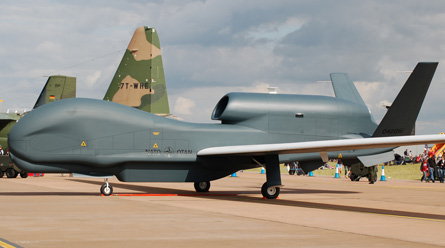NATO's long-running process to acquire an Alliance Ground Surveillance (AGS) capability has taken a significant step forwards, with 15 nations having signed a memorandum of understanding to advance the project.
Made on 25 September, the agreement will enable prime contractor Northrop Grumman and its multinational industry partners to complete their proposal for the RQ-4B Global Hawk unmanned air vehicle-based AGS system. The US company will then enter into negotiations that it believes will "support contract award next year".
 |
|---|
© Craig Hoyle/Flight International |
NATO RQ-4Bs (model pictured at RIAT 2009) will enter use from 2012 |
The MoU signature also sets the budgetary and legal frameworks for an equipment purchase, and clears the way for the creation of two new bodies to oversee the deal: respectively the NATO AGS Management Organisation and the NATO AGS Management Agency.
NATO says its AGS system - which is expected to comprise eight Block 40-standard Global Hawks and related ground control and image exploitation equipment - to enter service in 2012. A main operating base for the type will be established at Sigonella, Sicily.
The high-altitude, long-endurance UAVs will be equipped with the Northrop/Raytheon multi-platform radar technology insertion programme sensor, which will supply synthetic aperture radar and ground moving target indication data in support of alliance operations.
The MoU was signed by partner nations Bulgaria, Canada, the Czech Republic, Denmark, Estonia, Germany, Italy, Latvia, Lithuania, Luxembourg, Norway, Romania, Slovakia, Slovenia and the USA.
However, NATO says "participation to the programme remains open to other interested allies".
NATO has previously said that it expects the AGS programme to cost around €1.5 billion ($2.2 billion).
UAV page image © Northrop Grumman
Source: Flight International
















